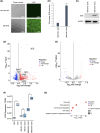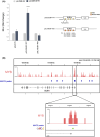The mitotic checkpoint kinase BUB1 is a direct and actionable target of MYB in adenoid cystic carcinoma
- PMID: 38112379
- PMCID: PMC11774229
- DOI: 10.1002/1873-3468.14786
The mitotic checkpoint kinase BUB1 is a direct and actionable target of MYB in adenoid cystic carcinoma
Abstract
Adenoid cystic carcinoma (ACC) is a head and neck cancer that frequently originates in salivary glands, but can also strike other exocrine glands such as the breast. A key molecular alteration found in the majority of ACC cases is MYB gene rearrangements, leading to activation of the oncogenic transcription factor MYB. In this study, we used immortalised breast epithelial cells and an inducible MYB transgene as a model of ACC. Molecular profiling confirmed that MYB-driven gene expression causes a transition into an ACC-like state. Using this new cell model, we identified BUB1 as a targetable kinase directly controlled by MYB, whose pharmacological inhibition caused MYB-dependent synthetic lethality, growth arrest and apoptosis of patient-derived cells and organoids.
Keywords: 3D assay; BAY1816032; ChIP sequencing; PDX; head and neck cancer.
© 2023 The Authors. FEBS Letters published by John Wiley & Sons Ltd on behalf of Federation of European Biochemical Societies.
Figures






References
-
- Ellington CL, Goodman M, Kono SA, Grist W, Wadsworth T, Chen AY, Owonikoko T, Ramalingam S, Shin DM, Khuri FR et al. (2012) Adenoid cystic carcinoma of the head and neck: incidence and survival trends based on 1973–2007 surveillance, epidemiology, and end results data. Cancer 118, 4444–4451. - PubMed
-
- Ferrarotto R, Heymach JV and Glisson BS (2016) MYB‐fusions and other potential actionable targets in adenoid cystic carcinoma. Curr Opin Oncol 28, 195–200. - PubMed
-
- Parikh AS, Wizel A, Davis D, Lefranc‐Torres A, Rodarte‐Rascon AI, Miller LE, Emerick KS, Varvares MA, Deschler DG, Faquin WC et al. (2022) Single‐cell RNA sequencing identifies a paracrine interaction that may drive oncogenic notch signaling in human adenoid cystic carcinoma. Cell Rep 41, 111743. - PMC - PubMed
Publication types
MeSH terms
Substances
Grants and funding
LinkOut - more resources
Full Text Sources

